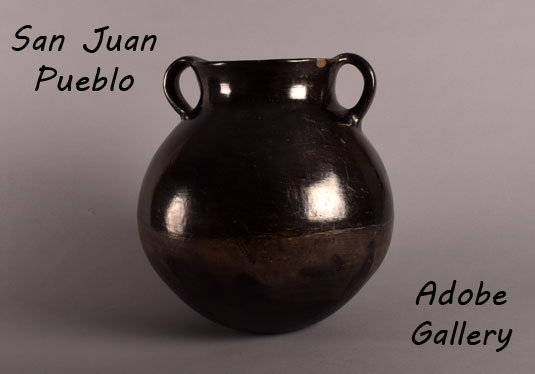Historic San Juan Pueblo Large Black Pottery Jar with Handles [SOLD]
+ Add to my watchlist Forward to Friend
- Category: Historic
- Origin: Ohkay Owingeh, San Juan Pueblo
- Medium: clay
- Size: 11-¾” tall x 12” diameter
- Item # C4444A SOLD
This is a traditional San Juan Pueblo pottery jar with a polished black upper body and polished gray underbody, a style which has been made for centuries. With historic pottery jars such as this one, a red slip is wiped over the upper part of the vessel body and the lower body is left without slip. Both upper and lower portions are then stone polished. When fired in a reduction atmosphere, the red changes to black and the tan underbody changes to gray. The interior of the neck is matte finish.
This jar has a beautiful globular shape which gracefully curves at the neck ending in a turned-out rim. It is such shapes that capture the eyes of collectors, particularly when the jar is so well stone polished, as is this one. The jar has two handles which are not frequently seen on San Juan Pueblo jars. The jar probably dates to circa 1900-1920, a time when pottery was being made for the market. The addition of handles was probably a concession to make the jar more appealing to a buyer. The interior of the jar does not reflect prior use at the pueblo.
By the early 1920s, merchants in Santa Fe were purchasing pottery directly from the potters at the nearby pueblos. Julius Gans, a merchant in Santa Fe, during the 1920s and 1930s, purchased pottery from San Juan potters by driving to the pueblos and visiting with them in person. A jar, such as this one, is quite likely what he purchased.
The arrival of the Spaniards in the late 1500s had extraordinarily little effect on pottery production at the pueblos in either shape or design, but by the 1700s, there were noticeable changes. Still later, with the opening of the Santa Fe Trail in 1821 and the arrival of the transcontinental railroad in 1880, change became inevitable at pueblos located close to the non-Indian populations.
San Juan Pueblo, now Ohkay Owingeh Pueblo - Place of the Strong People (its ancestral name), stayed with its original pottery traditions of simple undecorated utilitarian wares that were so beautiful in vessel shape and simple slipped surfaces highlighted by fire clouds. Even today, a hundred years after the pueblo abandoned its traditional style for a more modern style to appeal to tourists and collectors, the beautiful undecorated wares of the pueblo are still capturing the eyes of collectors. Vessel shape and surface finish are the keys to the beauty of San Juan blackware. There is no painted design to distract from the beauty of shape and sheen. The only decoration is the occasional fire clouds resulting from outdoor firing. Most collectors eventually warm up to the simplicity of San Juan pottery.
For those who wonder why San Juan potters only applied slip to the upper section of a jar, the answer comes in comparison with pottery from other Tewa-speaking pueblos. Potters from all the Tewa-speaking pueblos apply slip only to the upper parts of a jar, leaving the lower part un-slipped and stone polished. Because the upper parts of jars are painted with designs, the lower unpainted part does not attract attention. San Juan potters have just done the same, but it appears more unusual since there is no painted design on the upper section, and one wonders why they did not apply the slip all the way down. The answer is it is a Tewa tradition that only appears more prominent because there are no painted designs to offer distractions.
Condition: this Historic San Juan Pueblo Large Black Pottery Jar with Handles is in exceptionally good condition with one minor chip at the rim
Provenance: from the collection of Susan McGreevy, former director of the Wheelwright Museum in Santa Fe, and author of several books.
Recommended Reading: The Native American Curio Trade in New Mexico by Jonathan Batkin
TAGS: Southwest Indian Pottery, San Juan Pueblo, Historic Pottery

- Category: Historic
- Origin: Ohkay Owingeh, San Juan Pueblo
- Medium: clay
- Size: 11-¾” tall x 12” diameter
- Item # C4444A SOLD
Adobe Gallery Recommended Reading
Adobe Gallery Recommended Items
If you are interested in this item, we would also like to recommend these other related items:



